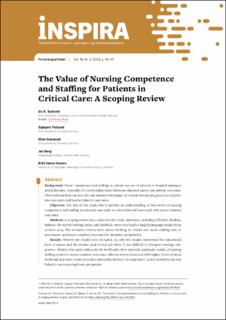| dc.contributor.author | Stafseth, Siv Anna Ulla-Britt Karlsson | |
| dc.contributor.author | Flatland, Sigbjørn | |
| dc.contributor.author | Granerud, Ellen | |
| dc.contributor.author | Berg, Jan | |
| dc.contributor.author | Hansen, Britt Sætre | |
| dc.date.accessioned | 2024-02-19T14:06:37Z | |
| dc.date.available | 2024-02-19T14:06:37Z | |
| dc.date.created | 2024-01-08T09:40:27Z | |
| dc.date.issued | 2023 | |
| dc.identifier.citation | Stafseth, S.K., Flatland, S., Granerud, E., Berg, J., Hansen, B.S. (2023) The Value of Nursing Competence and Staffing for Patients in Critical Care: A Scoping Review. Inspira, 18(2) | en_US |
| dc.identifier.issn | 0809-9707 | |
| dc.identifier.uri | https://hdl.handle.net/11250/3118502 | |
| dc.description.abstract | Background: Nurse competence and staffing in critical care are of interest to hospital managers and politicians, especially if a relationship exists between educated nurses and patient outcomes. Observational data can describe and measure the impact of critical care nursing practices in intensive care units and may be linked to outcomes.
Objective: The aim of this study was to provide an understanding of how levels of nursing competence and staffing in intensive care units are described and associated with nurse-sensitive outcomes.
Methods: A scoping review was conducted. Electronic databases, including CINAHL, Medline, Embase, the British Nursing Index, and SweMed+, were searched for English language studies from 2006 to 2023. The inclusion criteria were nurses working in critical care, nurse staffing ratio or assessment, and nurse-sensitive outcomes for intensive care patients.
Results: Twenty-one studies were included. As only few studies mentioned the educational level of nurses and the studies used several job titles, it was difficult to interpret nursing competence. Studies that used valid tools for workloads often reported significant results of nursing staffing related to nurse-sensitive outcomes. Adverse events increased with higher levels of nurse workload, and some events were also affected by the level of competence. Lower mortality rate was linked to more nursing hours per patient.
Conclusion: We found associations between education, nurse staffing, and nurse-sensitive outcomes in intensive and critical care units. To highlight its effects, advanced nursing competence in critical care and research must be better described. Patients’ need for nursing competence must be assessed using validated tools. | en_US |
| dc.language.iso | eng | en_US |
| dc.rights | Navngivelse 4.0 Internasjonal | * |
| dc.rights.uri | http://creativecommons.org/licenses/by/4.0/deed.no | * |
| dc.subject | intensivsykepleie | en_US |
| dc.title | The Value of Nursing Competence and Staffing for Patients in Critical Care: A Scoping Review | en_US |
| dc.type | Peer reviewed | en_US |
| dc.type | Journal article | en_US |
| dc.description.version | publishedVersion | en_US |
| dc.rights.holder | © 2023 Siv K. Stafseth, Sigbjørn Flatland, Ellen Granerud, Jan Berg, Britt Sætre Hansen | en_US |
| dc.subject.nsi | VDP::Medisinske Fag: 700::Helsefag: 800::Sykepleievitenskap: 808 | en_US |
| dc.source.volume | 18 | en_US |
| dc.source.journal | Inspira – tidsskrift for anestesi-, operasjon- og intensivsykepleiere | en_US |
| dc.source.issue | 2 | en_US |
| dc.identifier.doi | 10.23865/inspira.v18.3052 | |
| dc.identifier.cristin | 2221944 | |
| cristin.ispublished | true | |
| cristin.fulltext | original | |
| cristin.qualitycode | 1 | |

